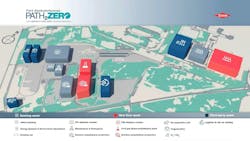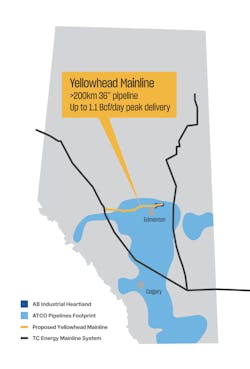Dow’s net-zero petrochemicals project progresses in Alberta
Dow Chemical Canada ULC’s (Dow Canada) Fort Saskatchewan Path2Zero expansion and retrofit project, to be the the world's first net-zero Scope 1 and 2 emissions integrated ethylene cracker and derivatives complex upon completion, continues to progress in Alberta’s Industrial Heartland in the Edmonton region with announcements by three companies for related projects since end-August 2024.
These are: a project by Dublin, Ireland-based Linde, to build a blue hydrogen plant to help decarbonize the plant; a natural gas pipeline project by Calgary, Alta.-based ATCO Ltd. to provide feedgas for Linde’s plant and Dow’s expansion; and expansion of a rail terminal by Brandon, Man.-based Cando Rail & Terminals, to help ship additional product from Dow’s Path2Zero project to market.
On Aug. 27, 2024, Linde noted a signed long-term agreement to supply clean hydrogen to Dow’s Fort Saskatchewan Path2Zero Project. The company will invest more than $2 billion to build, own, and operate an integrated clean hydrogen and atmospheric gases plant on-site.
The new complex will use autothermal reforming, combined with Linde’s proprietary HISORP carbon capture technology, to produce clean hydrogen and will also recover hydrogen contained in off-gases from Dow’s ethylene cracker (Fig. 1).
In the first phase, Linde will supply the clean hydrogen, nitrogen, and other services to support Dow’s net-zero emissions petrochemicals plant. Linde’s complex will also supply clean hydrogen to existing and new industrial customers seeking to decarbonize their operations. In total, Linde’s complex will capture more than 2 million tonnes/year (tpy) of CO2 emissions for sequestration.
Upon completion in 2028, Linde expects the project to be the largest clean hydrogen production plant in Canada, and one of the largest in the world. It will also be Linde’s largest single investment and its second new world-scale clean hydrogen project, following a plan to supply clean hydrogen to Amsterdam-based OCI Global’s large-scale blue ammonia project on the US Gulf Coast, announced in February 2023.
"Linde's partnership is critical in enabling Dow to advance its plans to decarbonize our Fort Saskatchewan site while growing our business. Our customers are looking to Dow to help lower the carbon footprint of their products, and this is an important step in that direction,” said Edward Stones, business vice-president of energy and climate at Michigan-based Dow Inc., Dow Canada’s parent company.
At a news conference announcing its final investment decision (FID) for its Path2Zero project on Nov. 28, 2023, Jim Fitterling, chairman and chief executive officer of Dow Inc., said the company decided on Fort Saskatchewan for its first net-zero project because of the high-class workforce, low-cost natural gas and ethane, and access to existing CO2 transportation and storage infrastructure in Alberta’s Industrial Heartland. Additionally, the governments of Canada and Alberta have made incentives and subsidies available to support the project, he said.
The $6.5 billion project—excluding these governmental incentives and subsidies and investments by partners such as Linde—includes building a new ethylene cracker and increasing polyethylene capacity by 2 million tpy as well as retrofitting the site's existing cracker to achieve net-zero Scope 1 and 2 emissions. The investment is expected to deliver $1 billion of EBITDA growth per year at full run rates over the economic cycle while decarbonizing 20% of Dow's global ethylene capacity.
In terms of governmental incentives and subsidies, Dow’s project to expand capacity and decarbonize its Fort Saskatchewan petrochemical complex could see up to C$2.2 billion in tax credits and grants from the Canadian and Alberta governments. These include as much as C$400 million from the Canadian government’s new investment tax credits for carbon capture, utilization, and storage (CCUS) and clean hydrogen, and up to a C$1.8 billion grant through the Alberta Petrochemical Incentive Program (APIP).
Yellowhead Mainline
On Sept. 18, 2024, ATCO Energy Systems, a division of Canadian Utilities Ltd., an ATCO company, noted the filing of a regulatory application establishing the need for the Yellowhead Mainline project. Yellowhead Mainline serves as an expansion to TC Energy’s existing natural gas transmission system.
This application, the first of two to the Alberta Utilities Commission, allows for further steps, including ordering long lead-time material and equipment once approved, ATCO said.
Since announcing the Yellowhead Mainline project in May 2024, ATCO Energy Systems has identified several potential routes and completed preliminary engineering to further refine the project’s delivery capability and scope to provide an initial cost estimate.
The project will consist of 200-230 km of high-pressure natural gas pipeline and related control and compression infrastructure running from the Edson, Alta., area, where natural gas and liquids production from Deep basin continues to ramp up, to Alberta’s Industrial Heartland, abutting and including northeast Edmonton (Fig. 2).
ATCO expects the 1.1-bcfd pipeline to cost about C$2.8 billion, subject to further detailed engineering and tendering of supply contracts.
The company expects Yellowhead Mainline be on-stream fourth-quarter 2027 and plans to start construction in 2026, assuming relatively timely regulatory and internal approvals. The project is advantaged by being entirely in the Province of Alberta, which has well-established, constructive, and efficient regulatory processes, ATCO said.
The Yellowhead Mainline project is expected to create about 2,000 jobs during construction and will provide gas supply for the more than C$20 billion of infrastructure investment, and associated employment in Alberta by customers, including Dow’s Fort Saskatchewan Path2Zero project.
Sturgeon terminal expansion
On Sept. 19, 2024, Cando announced plans to double the size of its Sturgeon Multi-Purpose Rail Terminal in Alberta’s Industrial Heartland, with Dow to be an anchor tenant in the expanded terminal.
The expansion will have up to 2,500 new railcar storage spaces in a storage-in-transit (SIT) yard, and additional car capacity of up to 1,150 spaces on arrival-departure tracks – including the capacity to stage 12,000-ft unit trains – spread over 320 acres, Cando said.
Cando is planning to complete engineering design on the expanded Sturgeon terminal by end-2024 and plans to start construction in second-quarter 2025. The expansion is projected to cost up to C$200 million.
The Sturgeon terminal can currently stage and store about 3,600 railcars and covers 302 acres. At a cost of C$150 million, construction of Cando’s original Sturgeon rail terminal was completed in October 2020 and opened in Spring 2021.
“Cando’s Sturgeon Terminal is a key origin-destination for our customers to transport product east and west – but especially for the rail corridor to Prince Rupert [on Canada’s west coast]. The expansion allows us to grow with our customers as they expand and explore low-carbon solutions,” said Brian Cornick, president and chief executive officer of Cando Rail & Terminals.
Additional progress
Dow also is partnering with Luxembourg-based Ravago to provide third-party logistics for additional products from its Fort Saskatchewan Path2Zero plant, while Wolf Midstream is to ship captured CO2 from the project through its Alberta Carbon Trunk Line (ACTL), according to the November 2023 press release announcing Dow’s FID.
As owner and operator of the multi-party, open access ACTL, Wolf is a leader in the field of carbon capture, utilization, and storage (CCUS) and is the largest independent CO2 infrastructure operator in North America. Its system currently gathers 1.6 million tpy of CO2 from the NWR Sturgeon refinery and Nutrien Redwater Fertilizer plant, both in Alberta’s Industrial Heartland, delivering it to a storage site in Clive, Alta., between Edmonton and Calgary (Fig. 3).
Since the planned ultimate capacity of the ACTL system is 14.6 million tpy of CO2, there is excess space to provide immediate decarbonization solutions to emitters in the region, Wolf said.
Finally, Dow let two contracts in third-quarter 2023 to Flour Corp. to deliver construction related services for Path2Zero (OGJ Online, Dec. 8, 2023).
Fluor’s scope of work under the contracts covers engineering, procurement, and construction management (EPCM) services for the new ethylene cracker and associated utilities, power, and infrastructure, at a cost of more than $3 billion, the service provider said.
The EPCM contract follows Fluor being awarded front-end engineering and design in February 2023.
About the Author
Vincent Lauerman
Vincent Lauerman is a freelance writer based in Calgary, Alberta. Over his nearly 4-decade career he has worked as an analyst and journalist focusing on global and North American energy markets and issues, including a stint as New York Bureau Chief for Energy Intelligence.


